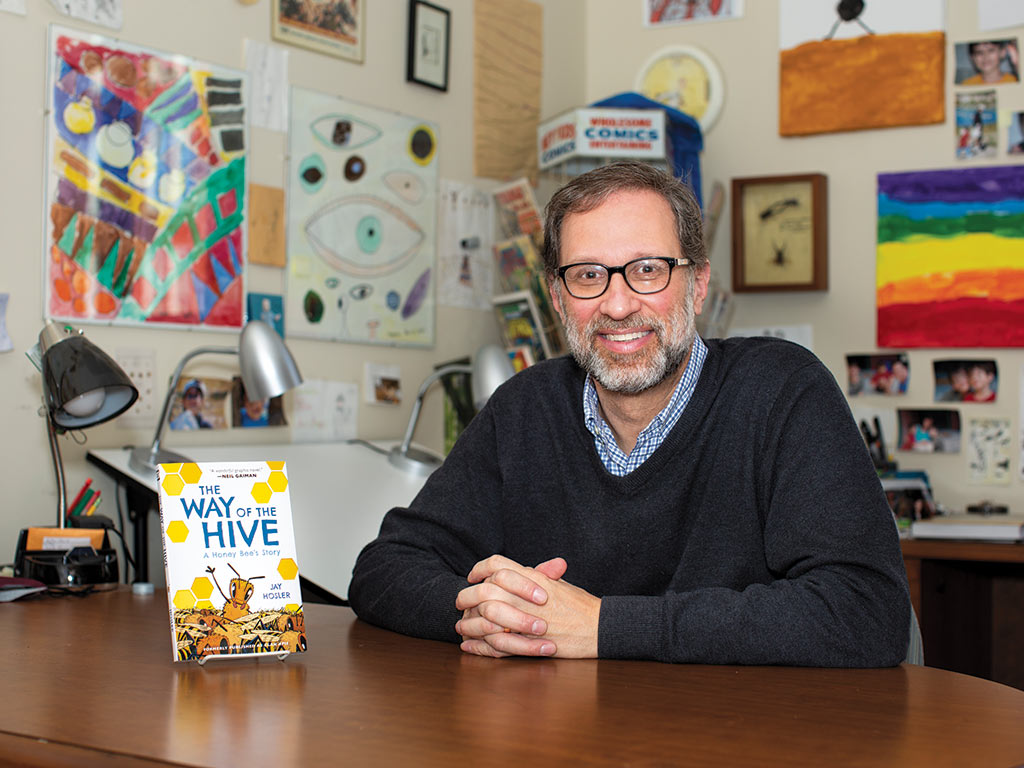After 20 years of teaching, what I want most is to inspire others to be curious. I need to inspire them to seek answers on their own. Jay Hosler
When a young Jay Hosler first sketched his favorite dinosaur, he probably couldn’t yet spell the word “interdisciplinary.” Even so, it was the first step on his journey to merge his love of the natural world with his passion for art.
Today, as the David K. Goodman ’74 Professor of Biology and chair of the biology department, his talent for sharing his fascination with science through storytelling is influencing the researchers and practitioners of tomorrow.
“After 20 years of teaching, what I want most is to inspire others to be curious,” Jay said. “I need to inspire them to seek answers on their own. I don’t want students to just be Pez dispensers who spit out answers.”
That lifelong celebration of curiosity and what began as a dearth of dinosaur illustrations suitable to please a young paleontology enthusiast led to a career as a biologist, author, illustrator, and educator.
“These days, you can go into a bookstore and find gloriously illustrated books about dinosaurs. When I was growing up, it was rarer,” he said. “I’ve always drawn, so if I wanted to see a battle between triceratops and tyrannosaurus rex, I had to do it myself.”
Jay’s love of drawing continued as an undergraduate biology student at DePauw University, and he honed his ability to combine writing and cartoons to create single-panel and four-panel sequences.
The fusion of biology, education, and drawing came about when Jay was reading The Biology of the Honey Bee by Mark Winston while completing his work toward a Ph.D. in biological sciences at the University of Notre Dame.
“When I read the book, I thought, ‘Someone should do a comic. Maybe I should do it’,” Jay said. “I applied things I learned from doing shorter strips into creating a longer story. I was learning on the job.”
He began to publish science comic books, using the money earned from one to cover the printing costs for the next. “It was a way I could combine my three interests, science, writing, and art,” he said. “I felt like I was contributing something new to comics.”
By the late 1990s, that idea had developed into Clan Apis, a series of five traditional comic books. A coming-of-age story told through the perspectives of three generations of worker bees, the narrative weaves a very human story within the context of the honeybee’s natural history. The collection was published together as a graphic novel in 2000.
Prior to coming to Juniata in 2000, Jay’s work with bees led him to a position as a National Institute of Health Postdoctoral Fellow at the Ohio State University’s Rothenbuhler Honey Bee Research Laboratory. Clan Apis was recently republished by Harper Collins as The Way of the Hive and was named one of the Best Middle-Grade Nature Books of 2021 by Kirkus Reviews.
Jay has also authored Evolution: The Story of Life on Earth and wrote and illustrated The Last of the Sandwalkers, The Sandwalk Adventures, and Optical Allusions.
“What I like to do with comics is to provide visuals to contextualize the story. It all dovetails,” Jay said. “When students see images or animations or are forced to draw various systems in biology, it solidifies information in a particular way.”
Jay’s students are familiar with his unpublished works in the form of sketches on a whiteboard or within class materials designed to illustrate biological concepts.
“I’ll make comics for my Introduction to Biology course, but a lot of it comes down to drawing on the board,” he said. “If I draw something on the board, students put it in their notes. That helps them figure out how to visualize something in particular in the moment.”
By using multiple sensory pathways in teaching, students are better engaged with the academic material.

“We are organisms who have evolved, and a lot of our success is based on our five senses, including vision,” said Jay. “That is a powerful source of information from the environment and a powerful way to communicate.”
Through the dynamic duo of Ant Edna, an ant named for Jay’s great-aunt Edna, Wilbur, a fruit fly protagonist from a bedtime story created by Jay’s father, and their fellow cast of characters, students at Juniata are given new avenues to explore biological concepts.
“It’s easier to remember stories than lists of terms,” Jay said. “You can have a baseline memory of concepts and terms, but if I can place them in terms of a story, you can provide a scaffolding that helps hold on to information and retrieve it to answer questions.”
His newest graphic novel, Santiago!, will be released on September 20 and is a true story based on the life of Santiago Ramón y Cajal, a visionary pioneer of modern neuroscience who dreamed of becoming an artist. Forbidden to pursue art by his parents, who wanted their son to become a doctor, Santiago continued to paint in secret while exploring scientific methods. Combining his interests in art and medicine, he won a Nobel Prize.
In his artistic and scientific pursuits, Jay credits the support of his wife, Lisa,
sons, Max and Jack, and his fellow faculty members as contributing
to his success.
“I’m very grateful that my colleagues in my department and across campus value this science communication work that I do,” he said.





